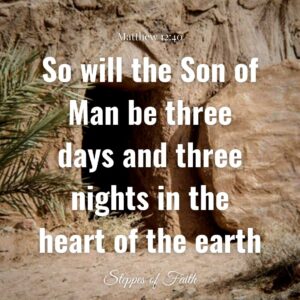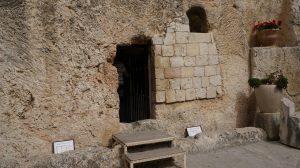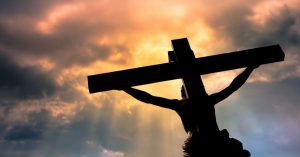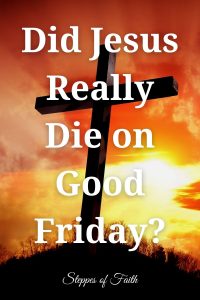
“So will the Son of Man be three days and three nights in the heart of the earth.” Matthew 12:39-40
Many of us somberly commemorate Jesus’ death on the cross on what we call Good Friday. We then think ahead to Sunday, the day of His glorious resurrection. Since every word of the Bible is true and accurate, we know He did indeed die and rise again the third day as He said He would. But exactly when was the third day?
Was the time between Jesus’ death and resurrection literally three days and three nights precisely as He said about Jonah’s time in the belly of a great fish? Or was He using an emphatic way of expressing time, as was common?
It has been and still is an excellent (if not controversial) topic of conversation. But understanding the Hebrew calendar in conjunction with Scripture helps us find a possible answer.
Jesus’ “Three Days and Three Nights”
Matthew 12 records a strange moment between Jesus and the Pharisees. The Pharisees wanted astronomical proof that Jesus is the Son of God. They asked not because they intended ever to worship Him but finally to have a reason to kill Him. And so, they asked Him for a sign. However, Jesus first criticizes the Pharisees, which implies that Jesus was not about to give an exact answer. Instead, He answers them cryptically.
“But He answered and said to them, ‘An evil and adulterous generation seeks after a sign, and no sign will be given to it except the sign of the prophet Jonah. For as Jonah was in the belly of the great fish, so will the Son of Man be three days and three nights in the heart of the earth.” Matthew 12:39-40
At the time, using the phrase “three days and three nights” was often an odd way of expressing a unit of time. For example, some might use “forty days and forty nights” to convey a period of just over a month. For “three days and three nights,” some argue it could be a way of saying “a few days.”
Likewise, in the Hebrew calendar, “three days and three nights” could mean any part of three consecutive days even if it did not add up to exactly 72 hours. It could be the end of one day, all the second day, and only the beginning of the third day, and it would still count as three days. Think of it as “today, tomorrow, and the next day.”
Being who He is, Jesus probably meant a literal three days and three nights. But that complicates things if we attempt to do any math here.
If Jesus died on a Friday and rose again on that Sunday, that’s only three days and two nights unless we apply the Hebrew calendar, which it doesn’t seem Jesus did. He said it would be a literal three days and three nights. So that means we would have to back up the biblical timeline of events that final week of His earthly life.
In other words, maybe He wasn’t crucified on a Friday but Thursday.
The Day of Unleavened Bread
The Bible does give possible evidence that Jesus died on a Thursday, and we find that in Mark 14:12, Luke 22:7, and John 13:1. Each of these Scriptures says the disciples prepared the Passover meal in the upper room on the Day of Unleavened Bread, which is also called the Day of Preparation. Part of this day is the morning and afternoon leading up to Passover, which begins at sunset. It was the day the priests prepared the sacrificial lambs in the temple, and families deep cleaned their homes.
The Day of Unleavened Bread is always on the fourteenth day of the first month (called Nisan) of the Hebrew calendar in accordance with Moses’ command found in Leviticus 23:5.
“On the fourteenth day of the first month at twilight is the LORD’s Passover.”
It is essential to note the Day of Unleavened Bread should not be confused with the Feast of Unleavened Bread, which is the official first day of Passover, though both days can be considered a part of Passover as a whole.
The first day of the Feast of Unleavened Bread immediately follows the Day of Unleavened Bread (Day of Preparation). So, the Day of Unleavened Bread begins at sunset on Nisan 14, and the first day of the Feast of Unleavened Bread begins on Nisan 15 at sunset.

Nisan 14
Scholars widely assume Jesus died in 30 A.D. According to the Hebrew calendar, Nisan 14 in 30 A.D. fell on a Wednesday, which means the disciples prepared the upper room for the Passover meal on a Wednesday. So, according to the gospel accounts, Jesus and His disciples ate their Passover meal together a full twenty-four hours earlier than everyone else.
Some might question why Jesus ate the Passover meal so early. Why didn’t He just eat it at the same time as everyone else?
Passover is a high holy day for the Jewish people. It is a very sacred day. It was important for Jesus to do all He needed to do before Passover began at sunset that Thursday. He needed to institute the Lord’s Supper (communion), attend three sham trials located miles apart, endure torture, drag His cross up to Golgotha, and hang on the cross for six hours.
There was not enough time to accomplish all this unless He ate the Passover meal early.
Matthew’s Interpretation
Only the book of Matthew says they ate the Passover meal during the Feast of Unleavened Bread (26:17). This could create an interpretive challenge until we understand that Matthew wrote his gospel by grouping events by theme and not necessarily by time. According to the MacArthur Commentaries, Matthew does not try to create a strict timeline; he simply lays out broad subjects such as the Sermon on the Mount and the parables.
As a result, Matthew lumps all the events of Jesus’ final days under the umbrella of Passover, meaning he rolls the Day of Unleavened Bread into the Feast of Unleavened Bread as one holiday. Even so, Matthew’s writings do not change the fact that Nisan 14 was a Wednesday in 30 A.D.
What About Sunday?
If Jesus and the disciples ate the Passover meal on a Wednesday evening, and the guards arrested Him that night, it would mean that Jesus died on Thursday, not Friday. But this presents another problem, according to the Hebrew calendar.
If Jesus was crucified on a Thursday, that would mean He was dead four days and three nights. Remember, the Hebrew calendar counts any part of a day as one whole day. So, the “four days and three nights” theory can’t be correct because Jesus said He would be dead only three days and three nights.
Unless we don’t count Sunday.
One theory is if Jesus died on a Thursday, He still would have fulfilled the “three days and three nights” prophecy because Thursday is day one, Friday is day two, and Saturday is day three. Remember, according to ancient Jewish culture, Saturday begins at sunset (what we call Friday night) and ends at sunset the next day.
In following this theory, Jesus was dead Thursday to Saturday (three days), but by Sunday, He was resurrected, which means He wasn’t dead on Sunday. So, when Mary Magdalene and the other women went to the tomb to anoint Jesus’ body very early on Sunday morning (Matthew 28:1, Mark 16:1, Luke 24:1), Jesus had already risen sometime between Saturday night and Sunday morning before the official fourth day began.

Double Sabbaths
In Luke 24:19-24, two unnamed disciples are walking to Emmaus when Jesus appears in disguise and joins them. As they walked, one of the men tells the stranger all that happened to Jesus between His death and resurrection.
We know this event occurred on the day of Jesus’ resurrection because verse 19 says, “Now behold, two of them were traveling that same day to a village called Emmaus.” We also read in Matthew 28:1, Luke 24:1, and John 20:1 that it was the first day of the week, which is Sunday in Jewish culture.
As they are walking with Jesus, one of them also says in verse 21, “Indeed, besides all this, today is the third day since those things happened.” So, if we count back with regard to the Hebrew calendar, Sunday was day three, Saturday was day two, and Friday was day one.
This theory keeps with traditional modern beliefs that Jesus died on a Friday. The only problem is that Passover began at sunset on Thursday (Nisan 15) and would last twenty-four hours.
Passover is an automatic Sabbath day (called a High Sabbath) when no one performs any work. In 30 A.D., this day occurred on Thursday at sunset. Once the High Sabbath was over, the Jews immediately observed the regular Sabbath from Friday evening to Saturday evening. In all, the two Sabbaths equaled forty-eight hours.
Two consecutive Sabbath days meant Jesus’ body had to be taken down from the cross and entombed before Passover began, or else it would have been left to rot in a mass Roman grave for two days. In keeping with Jewish tradition and out of respect, the disciples could not let that happen. It was imperative to take Jesus’ body down before the Passover began.
Because Passover began on a Thursday, Jesus couldn’t have died on a Friday because of the extended Sabbath’s timing. Luke 23:54 also confirms that Jesus did die on Thursday, the Day of Unleavened Bread (Day of Preparation).
“Then [Joseph of Arimathea] took [Jesus’ body] down, wrapped it in linen, and laid it in a tomb that was hewn out of the rock where no one had ever lain before. That day was the Preparation, and the Sabbath was near.” (Luke 23:53-54, my additions)
The following illustration may be helpful to understand the timing of events that week: Timeline of Jesus’ Last 4 Days
Jesus is All That Matters
The timeline of Jesus’ death and resurrection can be controversial. But if the Hebrew calendar is correct, then we can be open to the idea that Jesus died on a Thursday instead of a Friday.
Despite the apparent evidence, some might still argue that Friday is the correct date. And maybe it is. But as one professor of hermeneutics once said, “The timeframe proposed by proponents of such views is neither required nor supported by Scripture.” In other words, none of it matters.
It does not matter on which day Jesus died on the cross or rose again. All that matters is that He did.

